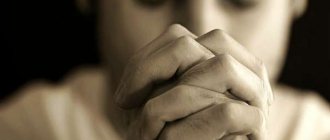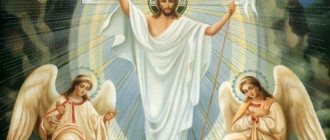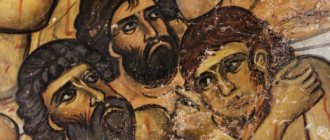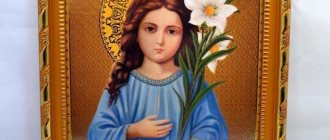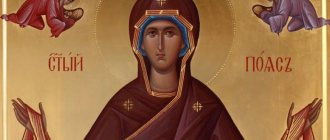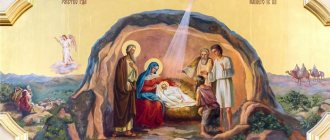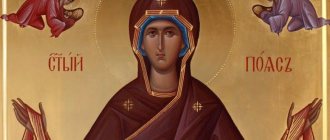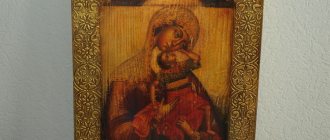The icon of the “Resurrection of the Lord” is a holy image created to constantly remind Christians of the great sacrifice of Christ, the price of the blood He shed and the great grace bestowed at the same time.
The birth of Jesus Christ changed the course of human life, opening a new century, however, without the Resurrection of the Savior, this event would not have had such significance. On the bright holiday of Easter, the great Lord, God the Son, descended into hell and took the keys to heaven from Satan, so that everyone who believes in the Savior would have eternal life.
Description and meaning of the classic image
The icons of the Resurrection of Christ depict the event that coincides with the holiday of Holy Easter, when the crucified Savior rose from the dead on the third day after the cruel execution. On the main day for believers, the day of the triumph of eternal life over worldly existence, God the Father resurrected God the Son, who descended into the underworld to save suffering souls.
To convey in a picturesque image the mysteries of the acts of Christ, who descended into hell for a good mission, and the process of resurrection itself, was a difficult task for icon painters. The plot depicted was based on the Gospel of Nicodemus. The Scripture was not included in the Bible, but it tells about events hidden from human eyes.
In a unique narrative, Nicodemus tells what happened after the burial of the tortured body of Christ. The devil triumphed and celebrated the murder of Jesus near the cross of Calvary until he learned about the coming of the Savior. Then the governor of hell ordered his assistants to lock the gates to the underworld so that Christ could not enter the terrible monastery.
The tricks of the evil one did not stop the Lord. The Savior destroyed the walls and took the keys to the gates behind which human souls languished.
Righteous souls followed Christ, who also brought the souls of the lost out of hell. The Lord is merciful and just. The grace of God will descend on the righteous, and sinners will be rewarded according to their deeds. The resurrected Jesus gives the righteous eternal life. Just as pure souls rose with the Lord on Easter day, so will God’s pious followers rise in future centuries.
Picturesque icons dedicated to the rise of the Savior from the tomb personify the power of God and the absence of anything not subject to His will. The images remind believers of the great sacrifice Jesus made for the people.
The mission of the Savior, who descended to the gates of hell to save the suffering righteous and sinners, is reflected in the classical image, which shows the resurrection of the Lord at the moment called “The Descent of Christ into Hell.” The first Orthodox icons were painted by Andrei Rublev and Dionysius.
In classical icons, the risen Christ is depicted in the center of the canvas in a shining robe. Behind the Savior is a blue-blue sphere, as a symbol of God’s grace. On both sides of the figure of Christ are depicted angels (cherubim, seraphim), holy saints and kings with golden halos.
Under the feet of the Son of God are depicted fragments of the destroyed walls of the underworld, an axe, nails, and keys, as a symbol of the fact that there are no barriers for the almighty Lord. Below, on the sides of Christ, the first sinners, Adam and Eve, are depicted, turning their pleading gaze to the Savior with a silent request for forgiveness. The Lord forgives their sins and takes those who repent by the hands.
The icon of the resurrection of Christ shows people that the path to God and eternal life is free, and where to go, the person himself must decide.
Interesting fact
It is noteworthy that according to the laws of Christianity, every action must be clearly regulated and confirmed by dogmas. This protects the church from any heresy and false teaching. Over the long years of its existence, the Christian religion has not only been subjected to numerous persecutions, but has also experienced attacks from new teachings that position themselves as the only true ones.
A serious dogmatic approach is also reflected in church art. On icons, every smallest detail should not go beyond accepted norms and dogmatic teachings. But the icon “The Resurrection of Christ” absolutely does not correspond to the rules formed over centuries. It is not based on canonical sources of information, which puts it in the category of unique paintings.
It is noteworthy that everything depicted in the icon we are describing is based on the Gospel of Nicodemus. This source of information dates back to the fifth century AD and describes in great detail all the events that occurred since the Resurrection of Christ, including his descent into hell. However, the canonical church completely rejects this source, which, however, does not prevent icon painters from relying on it in their works.
Modern versions of the icon
In addition to the classical image, icon painters embodied other subjects in their works, symbolizing the events of Easter day.
There are the following options for icons dedicated to the resurrection of Christ:
- An image of the resurrected Jesus ascending above the earth and holding the hands of the original sinners - Adam and Eve. The icon shows that the Lord brought everyone who followed Him out of darkness into the light.
- Depiction of the moment of Christ's appearance to those in hell. The Savior holds Adam and Eve by the hands, and at His foot in the darkness angels pacify demons.
- Depiction of Christ as he moves from top to bottom for those awaiting salvation.
In modern icon painting, the mystery of the Resurrection is depicted in the form of the risen Christ at the moment of leaving the cave where He was buried. Jesus, illuminated by a bright light, appears before the guards, who bow their heads down in respect. Icons often depict angels bowing before Christ. With his right hand the Savior blesses those bowed down, and in his left hand he carries a banner on which a cross is depicted. The banner symbolizes the victory of eternal life over death.
On most icon paintings, the pictorial subject is presented against a golden background, testifying to the triumph of Divine power over evil and darkness, and to the indestructible power of the Almighty.
Historical compositions
Il. 5. Sarcophagus of Passion. In the center is the Sepulchre of Christ in the form of a cross with a chrismon. There are sleeping guards nearby. Birds herald the dawn and the Resurrection. Lateran Museum, Rome. IV century
Il. 6. The appearance of an angel to the myrrh-bearers. Icon from the festive rite of the Assumption Church of the Kirillo-Belozersky Monastery. 1497
In an effort to overcome the symbolism of the first centuries, early Byzantine art developed historical compositions [14]. It is based on the Gospel texts (Mt 28:1-10; Mk 16:1-13; Lk 24:1-10; Jn 20:1-18) and historical realities. We see images of the tomb of the Savior in the form of a cross with a chrysmon [15] (Ill. 5) or a temple built by Emperor Constantine on the site of the Resurrection (rotunda and basilica). Nearby are guards, myrrh-bearers, and sometimes an angel. In the scene “The Appearance of an Angel to the Myrrh-Bearing Women,” the tomb of the Savior in the 4th-6th centuries. depicted in the form of a rotunda or tent (Bamberg avorium of the 4th century, carved plate from the British Museum 320-330 (ill. 2); Milanese diptych of the 5th century, reliquary of the Sancta Sanctorum of the 6th century, miniature of the Gospel of Rabula 586, and etc.). Subsequently, the plot of the appearance of an angel to wives became “extremely popular... both in monumental painting (mosaics and frescoes), and in book miniatures and applied art” [16]. In Rus', from the 15th century, when it was part of the festive row of the iconostasis, the icons “Angel and Myrrh-Bearers at the Tomb” (Ill. 6) and “The Appearance of Christ to the Myrrh-Bearers” appeared. The Holy Sepulcher is presented as a sarcophagus, where the lying white shrouds of the Savior are visible. The popularity of the plot is due to its significance in the entire gospel history. The Myrrh-Bearing Women, who found the Tomb empty, are the first witnesses of the Resurrection. This fact, as well as the joy that the angel preaches, is what prompted Christian artists to depict the mysterious meeting again and again [17].
What do they ask for in front of the icon?
In front of the icon of the Resurrection of Christ, believers pray for help in difficult everyday situations, for the resolution of physical and spiritual suffering. Often those who feel exhaustion of physical strength and mental devastation turn to the image.
Reading a prayer in front of the shrine helps those praying:
- to be healed from bodily illnesses;
- find peace of mind;
- get rid of sadness and despondency;
- to bring reason to loved ones who have strayed from the true path.
In front of the shrine, parents pray with requests that the Lord help bring their children to reason who have embarked on a sinful path and save fragile souls.
It is also customary to pray at the icon of the Resurrection of the Lord on the bright holiday of Holy Easter, remembering the torment and sacrifice of Jesus and chanting Him for salvation and grace.
What and who does the icon of the Resurrection of Christ help with?
Most often, those people who have fallen spiritually or physically turn to the holy image for help. Remember that the Lord always comes to the aid of those who ask for it, because there is no sin that the Creator would not forgive; if a person sincerely repents and calls on the name of Jesus, he will be saved.
Also, the icon often asks the mother for help about their unlucky children, praying, they have great hope that the moment will come and the Lord will lead the child out of the captivity of sin.
Prayer requests at the bright face help strengthen faith.
Having seen the Resurrection of Christ, let us worship the holy Lord Jesus, the only sinless one. We worship Thy Cross, O Christ, and we sing and glorify Thy holy resurrection: for Thou art our God, do we know no other to Thee, we call Thy name. Come, all you faithful, let us worship the holy resurrection of Christ: behold, joy has come through the Cross to the whole world. Always blessing the Lord, we sing of His resurrection: having endured crucifixion, destroy death by death.
Text of the prayer before the image
Reading a prayer in front of a shrine has special power. The main conditions are true faith in God, purity of thoughts, good intentions of the actions performed and adherence to Orthodox principles. The sincere appeal of a believer who fully trusts in the Lord will be heard in Heaven.
Believers ask for heavenly help and grace before the image of the sacrament of the Resurrection of the Savior with the following words:
“May the Lord rise again, and all His enemies will be scattered, and all those who hate Him will flee. All Demons will disappear like smoke, just as wax melts from fire. Before those who love God and are examined by the sign of the cross, all the devilish forces will perish.
In joy and hope, all believers exclaim: Rejoice, Honored and Life-giving Cross of the Lord, by the power of our beloved Lord Jesus Christ crucified upon you, you drive away all evil spirits. Our Great Lord Jesus Christ Himself descended into hell and destroyed the devil’s power and gave us You, the Honest Cross, which will help drive away every enemy from us.
Oh, Honored and Life-giving Cross of the Lord, help me who believes and prays, help me with the Holy Mother of God and with all the heavenly saints. Amen".
Church in Sokolniki
There are about five hundred churches in Russia, named after the most important event in Christianity. One of the most unusual is the church in Sokolniki. It was built at the beginning of the twentieth century, and the project itself, based on the traditions of Russian architecture, has a clear reference to Art Nouveau.
The temple has nine domes and three porches, decorated with exquisite carvings and arches. The structure is distinguished by a certain fragility, which has become its distinctive feature. The icons in the Church of the Resurrection of Christ in Sokolniki are considered real Orthodox shrines. Their names are dear to the heart of every Orthodox person: the icon of St. Panteleimon, the icon of the Passionate Mother of God, the substitute icon of the Bogolyubskaya Mother of God.
